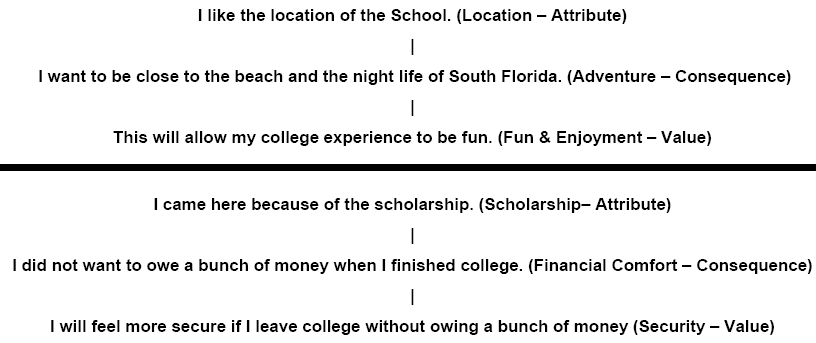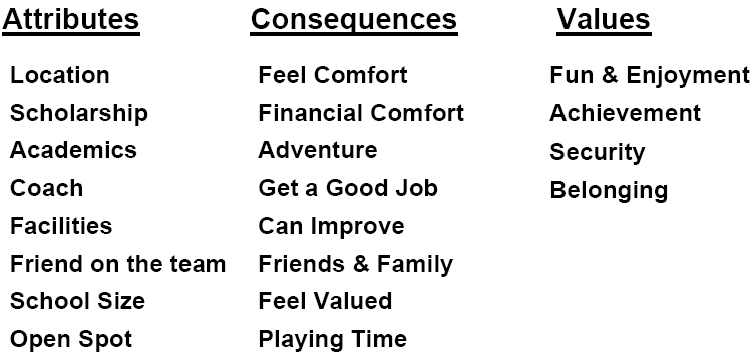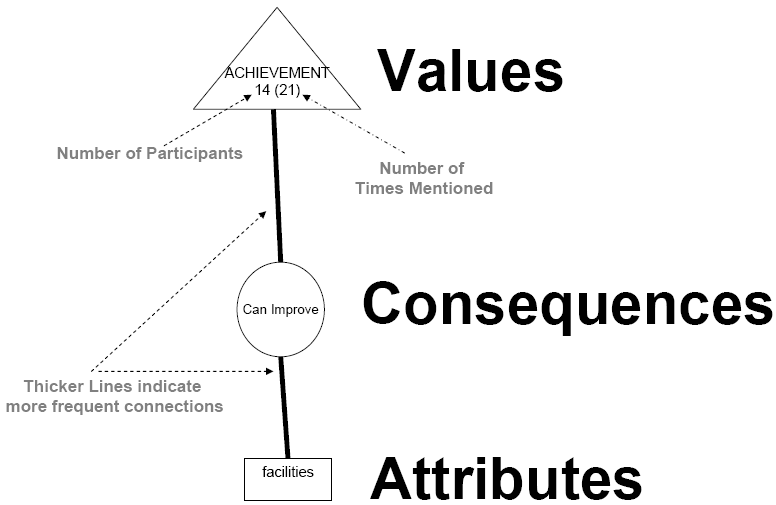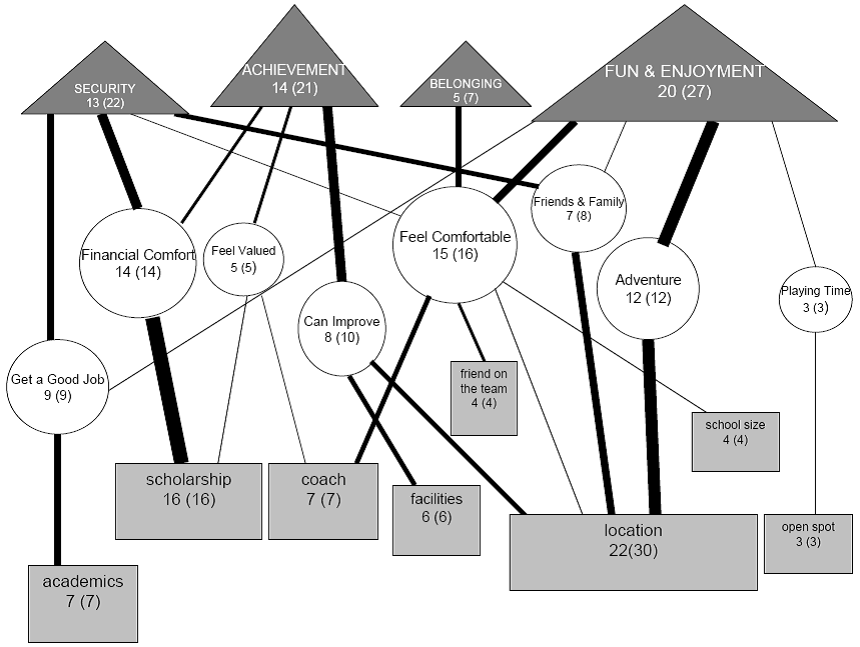National and State Youth Baseball Coaching Requirements: A State Case Study
Abstract
The purpose of this study was to determine the requirements placed on coaches by national and state youth baseball organizations. Administrators from five national youth baseball organizations and from five youth baseball leagues in Hawaii participated in the study (N = 61). A 12-item survey was used to determine the organizations’ requirements pertaining to coaches’ education, certification, experience, and professional growth. Results indicated no requirement by either the national or the Hawaii youth baseball organizations that coaches have a high school diploma. Furthermore, neither the national nor the state organizations required a national coaching certification. Only 6.98% of the national organizations and 11.11% of the Hawaii organizations required coaches to have experience as a player, while 4.65% of the national organizations and 7.41% of the Hawaii organizations required them to have prior coaching experience. Only 44.19% of the national organizations and 55.56% of the Hawaii leagues required background checks for coaches. Coaches’ attendance at coaching training seminars was required by 9.3% of the national and 11.11% of the Hawaii organizations. Clearly, youth baseball coaches in both national and state organizations are subjected to organizational requirements at minimal levels. Based on the results and on the existing literature, the authors recommend a model for certifying youth baseball (and other) coaches.
National and State Youth Baseball Coaching Requirements: A State Case Study
Through sports, youth coaches help parents and teachers develop the whole child or teenager in preparation for life. Sports are an important arena wherein coaches have the wonderful opportunity to guide and nurture the physical, mental, social, and emotional development of youth athletes. Coaching is of great value to society, according to Gilbert, Gilbert, and Trudel (2001), because there are millions of children and teenagers who “establish a segment of themselves in organized sports during a period of their lives that is critical to their personal development.” (p.29)Within the athletic arena, coaches assume the role of educator presenting youth with opportunities to learn and use both sports skills and life skills. But as Martens (2004) has argued, coaching is more than teaching, since “[c]oaches not only guide athletes in learning technical, tactical, and life skills, they also orchestrate and direct their lives in the performance of these skills” (p. vi)
The vast majority of youth programs in the United States rely on volunteers, notably parent-coaches (Wiersma & Sherman, 2005). Because of the volunteer nature of youth coaching, it is not surprising that coaches have various educational and athletic backgrounds (Martens, 2004). Most volunteer coaches receive only limited formal training or education in coaching to prepare them for their respective coaching endeavors (American Academy of Pediatrics, 2001; Gilbert et al., 2001; Gould, Krane, Giannini, & Hodge, 1990; Weiss & Hayashi, 1996). The majority of youth coaches nationally may be inadequately prepared to appropriately nurture children’s physical, mental, social, and emotional development. Research suggests that formal coaching education influences a coach’s ability to affect learning and performance in positive ways (Martens, 2004); coaching education is rarely mandatory (Clark, 2000), despite such findings. Furthermore, the available data describing standards that state and national sports organizations set for youth coaches are limited. The primary purpose of this study was, therefore, to determine these standards, or coaching requirements, in a sample of national youth baseball organizations as well as youth leagues in the state of Hawaii.
Methods
Every administrator (N = 61) at the five national youth baseball organizations and five statewide Hawaiian youth baseball organizations involved in the study completed a survey. These administrators included national directors, regional directors, and state directors, as well as the local presidents from the state leagues. The 12-item survey contained sections on (a) required certification, (b) required play and coaching experience, (c) required continuing professional education, and (d) educational background. Each survey question was designed to elicit a yes response (1) or a no response (2). The instrument’s intent was, first, to obtain from each administrator a description of any coaching certification that was required of or recommended for head baseball coaches by the organization (Questions 1–3). Next, the survey asked about experience head baseball coaches might be required to present, both as players and as coaches, and also whether they underwent any criminal background check (Questions 4–6). Then, the survey asked whether an organization required head baseball coaches to demonstrate professional growth through formal continuing education, and whether mandatory meetings of team parents were (Questions 7–10). Finally, the instrument surveyed the administrators about any education requirements established for head baseball coaches (Questions 11–12) (see Table 1). Frequency distributions and percentages quantifying the administrators’ responses were determined so that the five Hawaii youth baseball leagues could be compared and contrasted. Data were analyzed using descriptive statistics.
Results
Table 1 and Table 2 present descriptive statistics. Concerning the required certification of coaches, results indicate that neither the surveyed national youth baseball organizations nor the surveyed state leagues required any formal certification of head baseball coaches. In addition, according to the administrators, only three national organizations (6.98%) required head coaches to pass CPR and first aid certification examinations before they could act as coaches (see Table 1). One local president of a Hawaii state league similarly required coaches to obtain CPR and first aid certification prior to the season (see Table 2).
Concerning play and coaching experience required of coaches by national and state youth baseball organizations, only 3–5% of the national organizations required their head coaches to have any playing experience or any earlier coaching experience in baseball prior to coaching. Similarly, only 7–11% of the surveyed administrators from Hawaii state leagues reported that league coaches were required to have experience playing or coaching baseball.
In addition, only 44.19% of the national organizations required background checks for head baseball coaches prior to their assignment as coaches. Hawaii league administrators were slightly more likely to require background checks (55.56%), with just over half reporting their organizations required background checks.
Table 1
Number & Percentage of National Organization Administrators’ Yes/No Responses to 12 Items
| Requirement | Little | League (n = 9) | PONY (n = 1) | Babe Ruth/ | Cal Ripken (n=4) |
|---|---|---|---|---|---|
| Yes | No | Yes | No | Yes | |
| Certification of head coach mandated by national group | 0 (0%) | 9 (100%) | 0 (0%) | 21 (100%) | 0 (0%) |
| Certification mandated by national group may be modified by administrator | 9 (100%) | 0 (0%) | 18 (85.71%) | 3 (14.29%) | 4 (100%) |
| CPR/first aid certification of head coach | 2 (22.22%) | 7 (77.78%) | 1 (4.76%) | 20 (95.24%) | 0 (0%) |
| Baseball playing experience of head coach | 0 (0%) | 9 (100%) | 3 (14.29%) | 18 (85.71%) | 0 (0%) |
| Baseball coaching experience of head coach | 0 (0%) | 9 (100%) | 2 (9.52%) | 19 (90.48%) | 0 (0%) |
| Criminal background check for head coach | 7 (77.78%) | 2 (22.22%) | 4 (19.05%) | 17 (80.95%) | 0 (0%) |
| Annual examination over rules & regulations for head coach | 0 (0%) | 9 (100%) | 1 (4.76%) | 20 (95.24%) | 0 (0%) |
| Academic preparation in coaching for head coach | 0 (0%) | 9 (100%) | 4 (19.05%) | 17 (80.95%) | 0 (0%) |
| Seminars in coaching offered to head coach | 9 (100%) | 0 (0%) | 14 (66.67%) | 7 (33.33%) | 2 (50%) |
| Mandatory team parent meetings | 1 (11.11%) | 8 (88.89%) | 8 (38.10%) | 13 (61.90%) | 0 (0%) |
| High school diploma needed by head coach | 0 (0%) | 9 (100%) | 0 (0%) | 21 (100%) | 0 (0%) |
| College degree needed by head coach | 0 (0%) | 9 (100%) | 0 (0%) | 21 (100%) | 0 (0%) |
Table 2
Number & Percentage of National and State Administrators’ Yes/No Responses to 12 Items
| Requirement | National | (n = 34) | Hawaii | (n = 27) |
|---|---|---|---|---|
| Yes | No | Yes | No | |
| Certification of head coach mandated by national group | 0 (0%) | 43 (100%) | 0 (0%) | 27 (100%) |
| Certification mandated by national group may be modified by administrator | 40 (93.02%) | 3 (6.98%) | 26 (96.30%) | 1(3.70%) |
| CPR/first aid certification of head coach | 3 (6.98%) | 40 (93.02%) | 1(3.70%) | 26 (96.30%) |
| Baseball playing experience of head coach | 3 (6.98%) | 40 (93.02%) | 3 (11.11%) | 24 (88.89%) |
| Baseball coaching experience of head coach | 2 (4.65%) | 41 (95.35%) | 2 (7.41%) | 25 (92.59%) |
| Criminal background check for head coach | 19 (44.19%) | 24 (55.81%) | 15 (55.56%) | 12 (44.44%) |
| Annual examination over rules & regulations for head coach | 1 (2.33%) | 42 (97.67%) | 0 (0%) | 27 (100%) |
| Academic preparation in coaching for head coach | 4 (9.30%) | 39 (90.70%) | 3 (11.11%) | 24 (88.89%) |
| Seminars in coaching offered to head coach | 31 (72.09%) | 12 (27.91%) | 20 (74.07%) | 7 (25.93%) |
| Mandatory team parent meetings | 9 (20.93%) | 34 (79.07%) | 6 (22.22%) | 21 (77.78%) |
| High school diploma needed by head coach | 0 (0%) | 43 (100%) | 0 (0%) | 27 (100%) |
| College degree needed by head coach | 0 (0%) | 43 (100%) | 0 (0%) | 27 (100%) |
Finally, concerning the professional growth or continuing education of youth baseball head coaches, only a small portion (9.30%) of the national organizations required head coaches to complete any coaching education prior to becoming a head coach, according to surveyed administrators. A similar 11.11% of the state organizations required coaching education for head coaches. While the organizations tended to lack continuing education requirements for head coaches, 80% of the studied organizations at the national level did offer seminars for their coaches (see Table 1), as did 74.07% of the Hawaii baseball leagues (see Table 2).
In addition, 3 of the 5 national organizations did not mandate team parent-coach meetings, and the remaining 2 indicated that only a small number of coaches in the organization held parent meetings at which head coaches addressed team goals and rules, player responsibilities and discipline, and parents’ and coaches’ behavior. The survey data from administrators of Hawaii leagues were similar, with only 22.22% mandating or even offering a limited number of team parent meetings.
Discussion
The results of this study are consistent with the majority of published work, although they do challenge a few earlier findings. Concerning certification, for example, our survey findings support the literature, with no contradictory results obtained: The national organizations and Hawaii organizations require no formal certification of coaches. The present findings furthermore show that the national administrators, collectively, joined the Hawaii local presidents in reporting that the organization or league they represented had autonomy to modify certification requirements. (Nevertheless, according to this study’s results, neither national nor Hawaii youth baseball administrators have created certification requirements for their coaches.)
Findings of the present study diverged from those in the literature, however, in terms of required CPR and first aid certification of coaches. According to earlier published research, no national organization requires CPR and first aid training for coaches. Our survey findings identified three administrators (from the Little League and PONY organizations) who said they required head baseball coaches to become CPR and first aid–certified; in addition, one local president in a Hawaii organization required coaches to obtain such certification prior to the season. This raises a meaningful question: Given that the present study found national and Hawaii administrators alike to affirm their autonomy to modify the certification requirements applied to coaches, why did only four of them deem CPR and first aid certification important enough to mandate?
Concerning the experience requirements established for head coaches, the present results might be described as disturbing. Only a very small percentage (see Tables 1 and 2) of national administrators (6.98%) and Hawaii league local presidents (11.11%) said their organizations required coaches to have played baseball in high school. While play experience does not guarantee that a coach can motivate each player to psychomotor, cognitive, and social growth, coaches who played in high school seem likelier than coaches lacking that background to offer the relevant experiences (and strong knowledge base) that benefit teams. DeRenne’s discussion (1993) of four “I’s” suggests goals for the volunteer parent-coach, all of which are built on the kind of information a former player should possess. According to DeRenne, team members must be informed, instructed, and inspired by the coach if coaching is to be successful; to accomplish these tasks requires good information, for which even the best intentions are no substitute (1993).
Even more disturbing than organizations’ lack of requirements about coaches’ experience as players is their lack of standards concerning prior coaching experience. An astoundingly low 4.56% of national administrators and 7.41% of Hawaii administrators (see Table 1 and Table 2) required their head coaches to have prior baseball coaching experience. First-year head coaches who are appointed or elected “team leader” despite having no athletics background may find the road difficult to navigate; on the other hand, the first-year head coach who is an experienced assistant coach steers clear of many difficulties. It should be remembered that on-the-job training of coaches comes at the expense of players. DeRenne (1993) has also addressed the importance of experience as well as information, writing that knowledge is the sum of information plus experience, and noting that, “[W]ith [k]nowledge comes AWARENESS. If you have good information, practical experience, and have gained some knowledge, you are dwelling more on what can go right and less on what can go wrong” (p. 11)
The present study’s findings furthermore diverged from the literature in terms of background checks for prospective coaches. According to one article on Little League Baseball, the organizations requires of all its coaches, volunteers, or other persons who may regularly contact Little League athletes to be cleared by a sex offender background check (“Criminal and Sex Offender Registry,” 2005). The present findings, however, showed only 77.78% of Little League administrators to require criminal background checks and substance abuse screenings for all prospective coaches. The Little League organization might look to its brother organization, the Police Activities League, or PAL, for a model of responsible administration: PAL demands 100% compliance with its background check policy concerning coaches.
In terms of professional growth or continuing education requirements for youth baseball coaches, the present findings indicate that national and Hawaii organizations send mixed messages to coaching volunteers. There was no annual rules-and-regulations examination for coaches in 97.67% of national organizations and in 100% of Hawaii organizations, according to our findings. Similarly, 90.70% of national organizations and 88.89% of Hawaii organizations did not mandate any coaching seminars or other training sessions, although, interestingly, they did tend to offer coaches optional seminars, clinics, or the like, in hopes of fostering professional growth (72.09% of national organizations, 74.07% of Hawaii organizations).
Finally, concerning coaches’ educational backgrounds, the present study found not one national or Hawaii league administrator who said an organization required head baseball coaches to hold a high school diploma or college degree. While a completed formal education does not in itself guarantee coaching success, diplomas do indicate some degree of responsibility and maturity, qualities that are necessary in those who lead young athletes.
Recommendations
The research findings prompt a strong suggestion to national and state youth baseball organizations that they adopt coaching certification as policy. Ideally, any prospective head coach in any national or state organization would be required to meet uniform certification criteria. Specific certification criteria should include (a) mandatory attendance to coaching training or seminars leading to successful completion of an examination; (b) passing an examination/certification in CPR and first aid; (c) mandatory preseason parent-coach team meetings, (d) high school playing experience, (e) high school diploma; (d) criminal background check extending to substance abuse, as well; (e) high school playing experience; and (f) experience as an assistant baseball coach or head coach in another sport.
Furthermore, it is recommended that the coaches be required to conduct mandatory pre-season meetings with team parents and that the youth baseball organizations each appoint a supervisor responsible to oversee and unify youth baseball policies based on guidelines from the National Alliance of Youth Sports (NAYS, 2005) recommendations. Finally, Wiersma and Sherman’s (2005) eight recommendations for preparing youth sports coaches also merit adoption. These researchers called for NASPE standards to be incorporated into “content that encompasses issues specific to communities” They also advocated league programs that foster mentoring between experienced and new coaches; called for consistency across organizations in terms of requirements for coaches’ preparation; and recommended board members’ greater presence at practices and games. Wiersma and Sherman also point to the benefits of season-long and even year-round educational opportunities for coaches, and also of university-community collaboration to devise and implement sound programs and policies. They argue that the content of coaching educational programs should suit the age, gender, and athletic level of an organization’s players. Finally, Wiersma and Sherman suggest, and the present researchers agree, that the purview of conduct codes for players’ parents should be limited to behavior that is observable, and that codes should accommodate “objective enforcement”
References
American Academy of Pediatrics, Committee on Sports Medicine and Fitness & Committee on School Health. (2001, June). Organized sports for children and preadolescents. Pediatrics, 107(6), 1459–1462. Retrieved March 28, 2008, from http:// aappolicy. aappublications.org/cgi/content/full/pediatrics;107/6/1459
National Alliance for Youth Sports. (n.d.) Recommendations for communities. Retrieved January 1, 2006, from http://www.nays.org/nays_community_recommendations.pdf
Clark, M. A. (2000). Who’s coaching the coaches? In J. R. Gerdy (Ed.) Sport in school: The future of an institution (pp. 55-65). New York: Teachers College, Columbia University.
Criminal and sex offender registry search tool available to local Little Leagues (2005). Little League Baseball, Updated January 7, 2005.
DeRenne, C., & House, T. (1993). Play ball: The new baseball basics for youth coaches, parents, and kids. Minneapolis, MN: West.
Gilbert, G., Gilbert, J., & Trudel, P. (2001). Coaching strategies for youth sports. Journal of Physical Education, Recreation and Dance, 72(5), 41–46.
Gould, D., Krane, V., Giannini, J., & Hodge, K. (1990). Educational needs of elite U.S. national team, Pan American, and Olympic coaches. Journal of Teaching in Physical Education, 9, 332–344.
Martens, R. (2004). Successful coaching. Champaign, IL: Human Kinetics.
Martens, R., Flannery, T., & Roetert, P. (2003). The future of coaching education in America. Retrieved September 15, 2004, from http://www.nfhs.org/cep/articles/futurecoaching.htm
National Association for Sport and Physical Education. (1995). National standards for athletic coaches. Dubuque, IA: Kendall/Hunt.
Weiss M., & Hayashi, C. (1996). The United States. In P. DeKnop, L. M. Engstrom, B. Skirstad, & R. Weiss (Eds.), Worldwide trends in youth sport (pp. 43–57). Champaign, IL: Human Kinetics.
Wiersma, L., & Sherman, C. (2005). Volunteer youth sport coaches’ perspectives of coaching education/certification and parental codes of conduct. Research Quarterly for Exercise and Sport, 76, 324–338.
Author’s Note: Correspondence for this article should be sent to Coop DeRenne,
Associate Professor, University of Hawaii, KLS Department, 1337 Lower Campus Rd.
Honolulu, Hawaii 96822. Email: Coop@Hawaii.edu.




